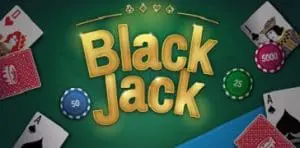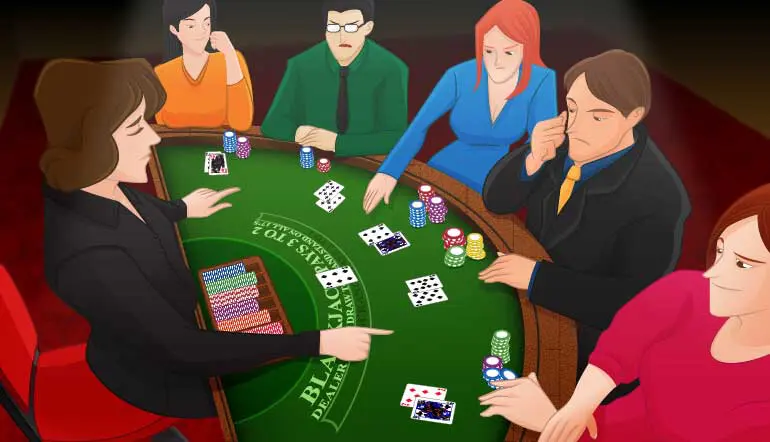Blackjack is characterized by having a lot of variety, but what most astonishes its players is the number of games that are still unknown to them. That’s why you should know the basics of blackjack in Spanish so you do not catch them off guard if you want to face that challenge.
 The basics in Spanish
The basics in Spanish
The difference between blackjack in Spanish and American or European blackjack when sitting at the table is a minimum; they are the same elements of the game, the players and the dealer. The goal of everyone at the table is to get the hand of the best value that is 21, or in your case a closed hand to beat the dealer. In appearance it is the same, but here are the differences.
It is normal for the player not to see the differences immediately; the dealer can card with 17 softs, but it is not like that normally, in many blackjack tables it is the opposite when there the dealer is in the 17.
Another difference is the number of decks that are used in games, in Spanish they usually use up to 8 decks, whereas Europeans use only 2 decks for blackjack; although those of the Americans vary from 2 to 8 decks to use in the game.
Spanish and American blackjacks are very similar when it comes to cards. Usually, the differences between these two ways of playing are noticed when you start playing before the dealer gets two first cards in different positions, one up and the hand that will be face down. To understand the differences well, you must continue reading.
How to play blackjack in Spanish
No matter which game variant you are playing in blackjack, the dynamic is to place the bet and get the two cards. But in the case of blackjack in Spanish, there are other valid options at the table, as well as many other ways to win.
When you start the game with the regular group, you can do the following,
- Take insurance.
- Hit or stand
- Bend
- divide
- Give up
You still do not notice the difference, during this process, but in the details is that you really notice. For example, each of the previously mentioned movements such as bending or surrendering are normal in all blackjack games, but in other games they can only be done in a few occasions, such as bending once or in the case of the divisions can only do it with Aces, so many small details that are not noticed at first. Generally, the rules of blackjack in Spanish are less restricted in terms of doubling and dividing and are more favorable for the player.
The restrictions for doubling are few, it can be done with any number of cards, then it can be doubled again; There are so few restrictions that after a division can be doubled again. But a contradiction to this rule is that you will not get a bonus after folding. The extra winnings will be explained later to clarify the doubts.
Division: Regarding the division. The rule is that if the cards have the same value they can be divided, also the cards of 10 are included although they are of different nature, like for example A and A. It also has the advantage of being able to divide the hand altogether three times, only until you have all 4 hands.
Surrender: The blackjack player can be favored at the time of surrender if he knows how to make his moves, in Spanish the strategy is well used since the player has a late surrender, and can use it in his own charity even when he has already doubled, in Spanish it is called double rescue. It is a good strategy.
How payments are given in Spanish and bonus earnings
To win a game of blackjack is only required to have a natural hand (bone 2 cards with a value of 21), or in any case when you get a higher hand than the dealer without having changed it.
The basic strategy in blackjack games in Spanish
There are modifications for each variant of the game of blackjack in Spanish like all other card games. To win blackjack there are many options to put into practice. It is best to take action during the game and have a hand of 5 or more cards that remain petrified by fear and not move forward. These situations are very common during games, it is normal for players to be afraid of the high bankruptcy rate. Once everything is lost there is no return.
To increase the income of the funds, many risks are taken, but the frequency of the profits can also be recovered. The important thing is to know what resources are available as strategies and know when to use them.
To what extent can you win or lose? You have to keep the balance of what is lost and win, for example, if the player loses $100 twice from the three times he has a bet, then he must do to re-raise at least $100. The percentage of profit is in $22 of possibilities of winning more than $100, in each session. Below $100, bands of 10 will be tracked (i.e., earning $1-10, $11-20, etc.). With these statistics the odds of winning $20 are given and in the same way you can lose $20; in this case, $100 was lost and the losses were unlimited. In this case, the odds of winning are greater when using the same betting pattern.
However, to win more than $100 with only a bet of $5 is very low, i.e. $6, which gives 14% below the second scheme, In this case, you have to study well which plan is the most convenient to play. Only the most practical player will have a logical answer.
The return will be the same for everyone, including players in Spanish and North American. In that case, the only thing different is the volatile and dynamic that the game can be. The biggest impact will be the bankroll, this must be very susceptible to the different amounts that will have to face, whether they are profits or losses.
For a professional player, it was not difficult for him to face the challenges of playing blackjack in Spanish. The differences can be minimal but very significant; an error in the game strategy and you can lose everything. Although you can also get benefits from the few restrictions that exist at the blackjack table in Spanish.
This is a very personal decision of each player; each one knows what he has to bet and how much he is willing to lose to get a big win. The ups and downs will be many, but a good blackjack player is willing to tolerate them. There are many surprises that blackjack has for its players in terms of variety.
Venturing Beyond the Surface: The Allure of Spanish Blackjack
Imagine blackjack as an iceberg. Most, tantalizingly hidden beneath the water, with only a fraction visible. Now, dive deeper. There lies Spanish Blackjack, its mysterious depths beckoning seasoned players and novices alike.
A Spanish Affair
Meet ‘Spanish 21’, a relative of traditional blackjack. Superficially, the scene is familiar: the dealer, the fervent players, and the age-old chase of that elusive 21. Yet, this game croons a different tune, whispering secrets to those who dare listen.
Decks & Twists: Spanish Blackjack throws a curveball – it ditches all 10-point cards. That leaves a 48-card deck. Sure, this might give the house a wee edge, but the game compensates with rules that favor the player. Quite the balancing act!
Rules, Refined:
Redoubling: Double down on any card number? Check. Then, redouble up, not once, but thrice? Double-check. But beware, if you’re thinking of that blackjack bonus after doubling down – it’s off the table.
Bonuses: Spanish Blackjack isn’t stingy. Five cards with a total of 21? That’s a 3:2 payout. Six cards? You’re looking at 2:1. And if you’ve got seven or more, that’s a shiny 3:1. Also, special combos like 6-7-8 or 7-7-7 of mixed suits? They’ve got bonuses up their sleeve.
Late Surrender & Double Down Rescue: Doubled and feeling dicey? Spanish Blackjack’s got your back. You can yank back the doubled bit of your bet. Got an Ace staring you down from the dealer’s hand? Even after doubling, you can deploy the ‘Double Down Rescue’.
Strategic Play
Spanish Blackjack? It’s not for the faint-hearted. Your typical strategy needs recalibrating. Go big, capitalize on the redouble, use that late surrender, but, and this is vital, know when to hold back. Every hand dealt is a narrative of risks and rewards, of bold advances and timely retreats.
Managing the Rollercoaster
Streaky. That’s Spanish Blackjack. Winds of fortune shift rapidly, with wins and losses coming thick and fast. Such volatility mandates careful bankroll management. It’s not just the amount you stake but the stamina to stay in the game that counts.
Spanish Blackjack burns with a fierce passion. It tempts, challenges, and rewards. Yet, as old hands will attest, irrespective of the variant – be it American, European, or Spanish – the true game is one of wit, tenacity, and nerve. Ready to dive deep? Let the cards decide your fate.
The Enigma of Spanish Blackjack
Peel back the layers of the blackjack family tree, and you might stumble upon Spanish Blackjack – a variant shimmering with complexity, yet imbued with a historical allure. Tracing its lineage, we find connections to Spain’s age-old ‘Ventiuna’, a moniker simply echoing ‘Twenty-One’. At the heart of it, you still chase the elusive 21 or aim to outmaneuver the dealer. But, Spanish Blackjack? It’s woven with intricate threads that set it apart.
Decoding the Side Bet Game:
One enticing element hidden up Spanish Blackjack’s sleeve is side bets. Often labeled ‘Match the Dealer’, this entails wagering on whether any of your first cards will mirror the dealer’s revealed card. Find a match, and you’re in for a treat. The stakes soar higher if you clinch a suited match.
Navigating the Five Card Trick:
There’s a sense of audacity in Spanish Blackjack. Accumulate five cards without bursting past 21? You’re rewarded with a bonus payout. This tactic, affectionately known as the ‘Five Card Trick’, injects a pulse-racing dimension.
Tilting the Scales:
While a tie in classic blackjack returns your bet, Spanish Blackjack throws in a quirk. Here, the player’s 21 trumps the dealer’s, shifting the scales in favor of strategy over sheer luck.
Mapping the Intricacies:
Spanish Blackjack isn’t merely about internalizing rules; it’s about mastering them. It’s a canvas of strategic brushstrokes, from harnessing the power of the redouble to exploiting bonus payouts. The truly adept don’t just play their cards; they delve into the game’s essence, navigating the labyrinthine alleys of its rules.
In Conclusion:
Spanish Blackjack isn’t just a game; it’s an art form. It beckons the curious, challenges the seasoned, and honors the traditions of a game that’s transcended eras. For those willing to unravel its mysteries and dance to its unique rhythm, it promises a blend of tradition and thrill. In the realm of Spanish Blackjack, every shuffle, deal, and call is an adventure, punctuated with surprises and revelations. Ready to take the plunge?


